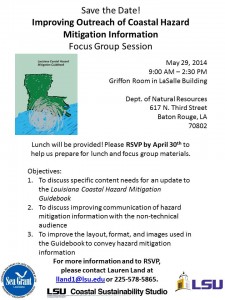Focus Group to Discuss the Improvement of Outreach for Coastal Hazard Mitigation Information
 On May 29th, Louisiana Sea Grant hosted a focus group discussion to follow up on the results of the survey we distributed in early 2014. We had 9 people attend the focus group, in addition to 7 project team members, for a total group size of 16 people. The 9 people represented a mix of local government, private industry, landowners, and university extension (AgCenter and Sea Grant). The purpose of the focus group was to build knowledge related to the delivery of hazard mitigation information by collecting participant knowledge and experience.
On May 29th, Louisiana Sea Grant hosted a focus group discussion to follow up on the results of the survey we distributed in early 2014. We had 9 people attend the focus group, in addition to 7 project team members, for a total group size of 16 people. The 9 people represented a mix of local government, private industry, landowners, and university extension (AgCenter and Sea Grant). The purpose of the focus group was to build knowledge related to the delivery of hazard mitigation information by collecting participant knowledge and experience.
We began the day with introductions and asked participants to describe the exact nature of their involvement in community outreach related to hazard mitigation. The type of outreach varied from person to person but was overall inclusive of publications, websites, workshops, and one-on-one meetings. Audiences receiving in-person outreach include elected officials, district boards, quarterly town hall meetings, public hearings, professional audiences, and public outreach events in partnership with private industry. The most consistent message was that outreach related to hazard mitigation is very much reactive to an event. After a storm is the time when people from the community approach the local government for information.
Next, project team member Zeynep Altinay (PhD Candidate in Mass Communications) gave an overview of the survey results to establish the context for the day’s discussion. The emphasis was on the fact that financial aspects present barriers to individual adoption of hazard mitigation actions, and there is a demand for more information related to the financial aspects of hazard mitigation. The discussion provided a natural segue into the next segment of the day in which we had participants discuss local government adoption of nonstructural measures to provide clarification on specific hazard mitigation information needs of three audiences: practitioner (i.e. local government departments), technical (contractors, banking, real estate), and non-technical (homeowners, renters, voters).
Two main information needs came up repeatedly in the discussion: homeowner elevation and how to make it affordable to the average homeowner. Designers and architects, rather than engineers, should be involved in communicating elevation information so it’s more understandable and appealing for homeowners. Through working with banks and real estate agencies, mitigation measures can be related to mortgage stages to show homeowners how they will recover their monetary investment in their property.
The next discussion focused on the process of hazard mitigation information transfer from the technical to the non-technical audiences and the factors that influence people to take action. Even in the age of digital technology, face-to-face meetings in communities are still effective ways to deliver information. Hosting educational events on the weekends and in churches and schools is a good way to reach a lot of people. Another suggestion is to partner with local news stations and local TV networks to deliver public service announcements related to hazard mitigation. In general, no single tool will reach all audiences. Outreach professionals need to utilize a broad variety of information and media channels and unique partnerships, such as partnerships with private industry.
In the afternoon, we heard from Rod Scott, a flood hazard mitigation specialist based in Mandeville. He presented us with his “Elevation 101” Seminar that he gave to over 4,000 people in 26 different public venues in New York and New Jersey communities affected by Hurricane Sandy. In partnership with an elevation company and local governments throughout New York and New Jersey, Rod’s seminar focused on the history, process, equipment involved, and rough cost estimates for residential elevation. He also covered various funding resources available to assist homeowners with elevation and tips for homeowners to consider when selecting an elevation contractor. After the seminar, residents could ask questions of both Rod and their local elected officials for further clarification. This unique partnership allowed homeowners, still in shock after disaster, to begin to understand how homes are elevated and what to consider as they make those decisions for themselves and their families.
Louisiana presents a need and an opportunity for this type of in-depth outreach. At the end of the focus group, participants casually discussed how an education campaign on homeowner elevation could be conducted in Louisiana. Stay tuned for the manuscript being developed on the use of the survey questionnaire and the focus group discussion to identify ways to improve hazard mitigation outreach in coastal Louisiana.
